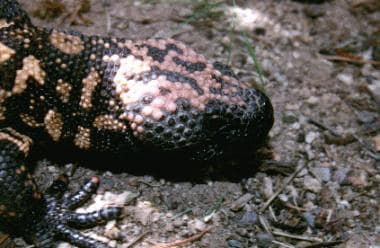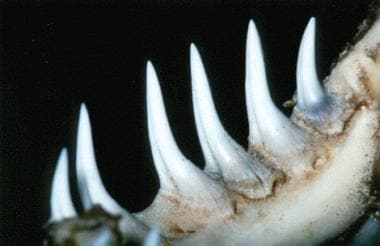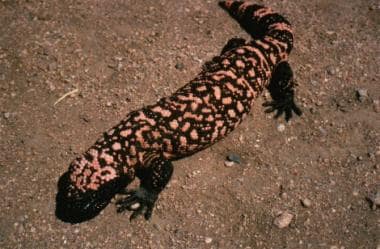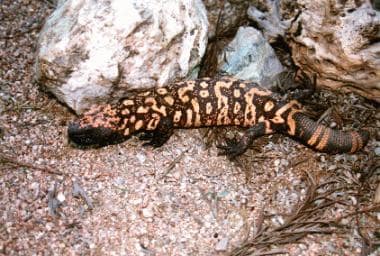Practice Essentials
There are 5 extant species of lizards known to be venomous, all belonging the the family Heloderma . The Gila monster (Heloderma suspectum with 2 subspecies) [1] , and 4 beaded lizard specias: the Mexican beaded lizard (Heloderma horridum), the Rio Fuerte beaded lizard (Heloderma exasperatum) the Chiapan beaded lizard (Heloderma alvarezi), and the Guatemalan beaded lizard (Heloderma charlesbogerti). [2, 3]
There is also ongoing debate regarding possible venom production by some other lizard species such as the Komodo dragon (Varanus komodoensis), but there is no current evidence to support human envenomations by any other lizards, [4] and these will not be further discussed in this article.
The Gila monster is found in the desert regions of Arizona, western New Mexico, southeastern California, [5] the southern tip of Nevada, extreme southwestern Utah, and northwestern Mexico. The four Bearded lizards are found in Mexico and Guatemala, south of the range of the Gila monster.
Heloderma spp lizards have heavy bodies with large heads and powerful jaws. The beaded lizards are larger than the Gila monster, reaching almost a meter in length, whereas the Gila monster's maximal size is approximately 0.5 m.
 Close-up of the head of a Gila monster. Clearly evident is the bulging musculature of the jaws, which gives this animal a tenacious bite. Photo by Holly McNally.
Close-up of the head of a Gila monster. Clearly evident is the bulging musculature of the jaws, which gives this animal a tenacious bite. Photo by Holly McNally.
Patient education
Bitten victims should receive instructions regarding standard wound care, elevation of the bitten extremity, signs and symptoms of infection, and medications to be taken.
Patients should be educated to avoid close interactions with potentially dangerous wildlife in the future.
Signs and symptoms
Also see Presentation.
Vital signs should be assessed and closely monitored.
Local signs are as follows:
-
Multiple bleeding lacerations
-
Edema
-
Cyanosis or ecchymosis
-
Vasospasm
-
Retained teeth (Closely examine wounds and probe for foreign bodies.)
-
Necrosis (rare)
Systemic signs are as follows:
-
Tachycardia
-
Hypotension
-
Respiratory distress
-
Diaphoresis
-
Lymphangitis and lymphadenopathy
-
Airway edema
-
Abdominal pain
-
Vomiting
Diagnostics
A chest radiograph should be obtained if the victim is experiencing chest pain, shortness of breath, or has significant comorbidities.
Soft tissue radiographs may be obtained to look for retained teeth, although the sensitivity is low. Occasionally, gas may be seen in the soft tissues and likely represents air introduced into the wound during the biting/chewing process. [6] A bedside ultrasound might also reveal retained teeth.
Obtaining an ECG is prudent. T-wave abnormalities, conduction disturbances, and 2 cases of acute myocardial infarction (one in a young patient without chest pain who had a possible history of cocaine use but no other cardiac risk factors) have been reported. [7, 8]
Also see Laboratory Studies.
Treatment
See Treatment and Medication.
Prevention
Avoid handling or otherwise disturbing venomous lizards.
Because these creatures spend approximately 99% of their lives underground, the opportunity to see one in the wild is a great privilege. The urge to pick up or capture it should be strongly suppressed. These animals are legally protected in all regions in which they occur.
Pathophysiology
The venom apparatus is much less sophisticated than that of most venomous snakes. A pair of multilobed labial venom glands (modified submandibular glands) lie in the anterior portion of the lower jaw. Venom is conducted from each lobe through a single duct (H horridum) or a series of ducts (H suspectum) and is deposited into a labial mucosal pocket adjacent to the anterior teeth. [9]
The teeth (approximately 20 per jaw) are grooved and loosely attached to the jaws. Venom is conducted via capillary action along these grooves into the victim's tissues as the lizard bites and chews. [2] The more irritated the lizard is when it bites, the more it salivates and the greater the venom yield. Effective envenomation in humans probably occurs in less than 70% of bites. Venom is thought to be defensive rather than digestive or for prey immobilization [2]
 The dentition of a Gila monster. The grooved surfaces of the teeth are evident. These grooves allow for venom movement from the venom glands into the victim's tissues. Photo by Michael Cardwell.
The dentition of a Gila monster. The grooved surfaces of the teeth are evident. These grooves allow for venom movement from the venom glands into the victim's tissues. Photo by Michael Cardwell.
The venoms of these lizards are remarkably similar and contain a number of components, including L-amino acid oxidase, hyaluronidase, phospholipase A, serotonin, and highly active kallikreins that release vasoactive kinins. The venom contains no neurotoxins or any enzymes that significantly affect coagulation. In laboratory animals, the venom is as potent as some rattlesnake venoms. Rare hypersensitivity to helodermatid venom has been reported. [10, 11]
Epidemiology
Frequency
United States
Bites are very infrequent and usually involve captive specimens. A significant number of bites probably go unreported because private keepers of these protected lizards may be reluctant to seek medical attention.
International
No data regarding current incidence of bites by venomous lizards in Mexico are available.
Timing
At least one study indicates Heloderma encounters are more freqeunt during warmer months [1]
Race-, sex-, and age-related information
No data are available to support any racial predilection to lizard bites.
Males are more frequently bitten [1] , likely due to increased interaction with these animals
While there are no large studies reporting the age distribution of venomous lizard bites, it is likely that those at greatest risk will be children, adolescents, and young adults. Young children may be at increased risk of bites if they come across a wild Heloderma specimen, as they may not comprehend the risk. Adolescents and young adults may be more prone to intentionally interact with or collect such lizards, despite knowing their venomous nature.
Prognosis
The prognosis is excellent for those with a lizard envenomation, although pain may be an issue for many days. Reports of Heloderma envenomations resulting in death are largely unconfirmed and no deaths have been reported in modern literature. [2] It is believed that a prolonged bite received by a small individual, such as an infant or toddler, could result in death.
Severe pain following a helodermatid bite may last many hours and generalized weakness can persist for several days. Other complications include abdominal pain, vomiting and diarrhea. More rare and life-threatening complications include shock, airway edema, myocardial infarction, cardiac dysrhythmia, allergic/anaphylactic reaction, and coagulopathy. [1, 11, 12, 7, 8]
-
A Gila monster (Heloderma suspectum). Photo by Holly McNally.
-
Close-up of the head of a Gila monster. Clearly evident is the bulging musculature of the jaws, which gives this animal a tenacious bite. Photo by Holly McNally.
-
The dentition of a Gila monster. The grooved surfaces of the teeth are evident. These grooves allow for venom movement from the venom glands into the victim's tissues. Photo by Michael Cardwell.
-
A Gila monster (Heloderma suspectum). Photo by Michael Cardwell.











